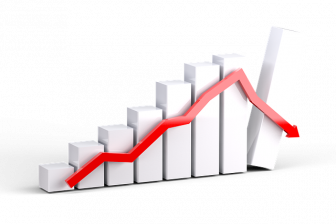 The average price of a residential property in the UK dropped by 0.4% in September to £278,601, marking the sixth consecutive month a decline was reported.
The average price of a residential property in the UK dropped by 0.4% in September to £278,601, marking the sixth consecutive month a decline was reported.
The Halifax house price index showed that the decline was softer than August when there was a 1.8% fall compared to the previous month.
Industry reaction:
Sam Mitchell, CEO of Purplebricks, said: “There is a large lag indicator to the Halifax data and what we at Purplebricks are seeing on the ground is sentiment turning towards the housing market. It has changed quite dramatically over recent weeks, driven by news inflation was lower than expected and the Bank of England’s somewhat unexpected decision to hold interest rates.

“Normally we would be seeing the start of a seasonal slow down at this point but instead we have seen a spike in both properties coming to market and buyers viewing and making offers. We can see that mortgage rates coming down is really helping consumer confidence in restarting house searches that have previously been paused and expect this momentum to continue through October.
“For tenants, this drop in rates is welcome news when rents have been at extortionate levels for some time now. For first time buyers, this is the first moment in many months when the dream of becoming a homeowner can become a reality.”
Fred Jones, COO at Upstix, commented: “Persistent inflation has led many to conclude that interest rates will stay higher for longer. As such, homeowners holding out for cheaper mortgages, a return to high demand, and a speedy recovery to the housing market will likely be disappointed. And as rate rises take time to feed through to the market, property owners should brace for more pain.
“Sellers in particular should be concerned that consistently low demand increases the likelihood of transactions collapsing and broken property chains. Time is now of the essence for those looking to avoid further falls in value.”
Verona Frankish, CEO of Yopa, said: “Today’s buyers are certainly facing a more challenging task when it comes to the cost associated with climbing the ladder and this is evident given the reduction in mortgage market activity seen in recent months.
As a result, the UK property market is currently treading water where house price growth is concerned, with little change on a month to month basis, while prices continue to sit below the highs seen this time last year.
However, interest rates have finally stopped climbing and although they remain at their highest since the spring of 2008, this should bring about a boost to buyer sentiments over the coming months.
All things considered, the market has so far weathered the storm with respect to the wider economic landscape and should continue to stand firm over the remainder of a year.”
James Forrester, MD of Barrows and Forrester, commented: “A sixth consecutive monthly fall may seem like cause for concern but what we’re currently seeing is the market readjusting following a sustained boom period that saw house prices driven to record highs.
This has materialised in the form of a slow but consistent reduction in values rather than the cliff edge drop that many predicted and despite this modest reduction, property values remain substantially higher when compared to the pre-pandemic benchmark.
Nathan Emerson, CEO at Propertymark, said: “The primary reason for the 4.7% fall in house prices, which is an acceleration on August’s 4.5% drop, is that borrowing costs are being affected by higher interest rates on mortgage affordability. Also, the Base Rate will remain high for a long time, and that will continue to have an impact. This just shows both the Bank of England and Rishi Sunak need to ensure inflation drops to 2 per cent in the very near future, otherwise 2024 will be a difficult year for homebuyers.”

Iain McKenzie, CEO of The Guild of Property Professionals, commented: “It comes as no shock that house prices have fallen slightly during the usual summer slowdown, especially in light of the ongoing squeeze on household bills.
“While the recent unexpected decision by the Bank of England to maintain the base rate at 5.25% was a relief for mortgage-dependent buyers, this rate is still significantly higher than last year. This has led many potential buyers to adjust their expectations and hold firm during price negotiations with sellers.
“Despite a slight dip in average house prices in September, affordability remains a concern, especially for first-time buyers who must consider the impact of higher monthly loan repayments.
“On the flip side of the coin, this gives more room for manoeuvre for cash buyers. While most people are exercising caution about potential overpayments, those with the financial means are in a favourable position, often securing deals below the asking price.
“The pause in base rate hikes, along with competitive mortgage rate reductions from various lenders, are indicators that the market is stabilising.
“Despite the financial challenges facing households, there remains robust demand for high-quality housing. Buyers have become accepting of the higher-rate environment, and sentiment is expected to improve further if interest rates hold steady.”
Tom Bill, head of UK residential research at Knight Frank, said: “The fact rising interest rates have caused a house price correction was predictable but the extent of the recent volatility was not. The combination of the mini-Budget and fourteen consecutive rate rises have taken their toll on demand but buyers and sellers should return in greater numbers as a sense of stability returns. The financial pain entering the system will continue next year as people roll off fixed-rate deals, but there will be an improvement in sentiment, that vital lubricant in the housing market. We therefore think most of the UK’s house price correction will happen this year and modest single-digit annual growth will return after the next general election.”
Nicky Stevenson, MD at Fine & Country, stated: “Squeezed buyer affordability is lowering house prices although they still remain much higher than pre-pandemic levels.

“The property market is offering a much stronger supply of homes than it did during 2021, when we saw frantic buying activity, and this is giving buyers much more choice and headroom to haggle — though it is also playing a part in pushing down prices during negotiations with sellers.
“However, the unexpected pause in base rate rises may result in a spike in demand which could balance this out over the coming months.
“We are seeing the usual uptick of autumn activity, but with the average time taken to finalise a sale close to 20 weeks, time is ticking for those wanting to move in by Christmas.
“The good news for sellers is that buyers looking to move are highly motivated, although those relying on mortgages are very conscious of their budgets and are being careful not to overstretch themselves.”
Jason Tebb, CEO at OnTheMarket.com, commented: “As the decline in average property prices continues, the high cost of living and numerous rate rises have understandably impacted how much buyers are willing and able to pay.
“However, given all the economic uncertainty it is remarkable how relatively stable the market appears to be as we head into what tends to be a busier period in the run-up to Christmas. September’s hold in interest rates has bolstered stability and confidence, with many borrowers hoping that we have seen the peak in base rate and that the worst of the pain is behind us.
“There may be fewer buyers than during the stamp duty holiday but those who are out there are committed and focused on moving. As well as not being speculators, they are price sensitive, so sellers must be sensible when it comes to pricing if they wish to achieve a timely sale.”
Jonathan Hopper, CEO of Garrington Property Finders, remarked: “Britain’s property price correction is far from over, but there are signs it is easing.
“The Halifax’s data marks the second time this week that a house price index has reported that monthly price falls are slowing.
“More and more sellers have accepted the reality that the market has shifted fundamentally since this time last year. The Halifax’s data shows that prices have fallen 4.7% in that time, and that the average home sold now is fetching £14,000 less than it would have when prices peaked last August.
“While many sellers are now being more realistic in setting their asking price, we’re still regularly seeing homes go for tens of thousands under asking as proceedable buyers press home their advantage.
“The big question now is how the easing of mortgage rate escalation might feed through into both prices and the number of sales. While no-one is expecting mortgages to get significantly cheaper any time soon, fixed rate deals have come down from their recent highs and there’s a growing hope that the peak is past.
“Cash buyers remain in the strongest position, but affordability is slowly improving for mortgage-reliant buyers too as prices continue to fall.
“With wage growth still strong, improving affordability should pep up demand over coming months, even if every buyer will continue to need to factor in price risk and higher borrowing costs into what they’re prepared to pay.”


Sam Mitchell is somehow the CEO of Purplebricks, despite the fact that he thinks that late September and early October normally see “the start of a seasonal slow down”. If this was any more incorrect it would go all the way round to being correct again!! September and October, along with April and May, are and always have been the busiest months of the year for Estate Agents (all other things being equal). How do these people rise to hold the positions that they do is honestly beyond me.
You must be logged in to like or dislike this comments.
Click to login
Don't have an account? Click here to register